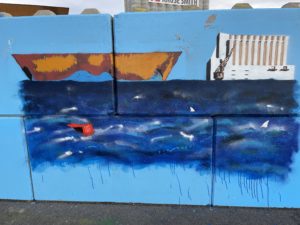I daily read newspapers/online newspapers. Mass media is an important part of the information society.
What I knew about Lesvos, before I signed up for the program, is that it is an island in Greece with a refugee- and medical crisis, and that there was a big fire in the Moria camp.
In addition I know that Greece has been in a debt crisis since 2010, the corona pandemic is going on in its 3rd year, President Erdogan in Turkey (across the strait from Lesvos) is in quarrels with Greece and creating political turbulence, heat waves have set heat records in Greece/southern Europe plus many tourists has avoided Greece in recent years. A perfect storm for Lesvos! A lot of negative, in other word.
Now I’m going to go there. My attitude is that we are going to have an inspiring, interesting, fun, social, wonderful experience of Lesvos and with the program.
I didn’t know any of the pictures before. I particularly liked the peace sign made of brightly coloured life jackets. It reminds me of a land art project that I like very much. Landart is often environmentally friendly art that I want to create on Lesvos. The most famous land art artist is Andy Goldsworthy. He creates sculptures that are placed in stone, ice, branches, etc. When I read about Lesvos, I quickly thought of the land artists Christo and Jeanne-Claude with their famous pink islands. I felt like “wrapping Lesvos” in something soft and healing for a time that will create peace, good communication and cooperation in political matters, and peace and quiet for tired islanders.



The rubbish heaps with life jackets and the refugees who throw life jackets off when they arrive on the beach are completely understandable. I was wondering why garbage trucks do not transport life jackets away and destroy them regularly? The life jackets now affect plant and animal life, and microplastics from the life jackets end up in nature.
After some thought, I found logic in the symbolic value of keeping the vests on the beaches. The mounds of life jackets tell new refugees that: “There have been thousands here before me. I’m just one of many, and the Greeks know how to help me.”
Authorities and journalists can now find hundreds of useless fake life jackets and inform the world, and thus also war-torn countries, that life jackets are sold filled with heat-insulating materials and sponge materials, so that the life jackets appear thick and safe, instead of floating elements. These are materials that absorb water, and lead to being dragged into the depths of the sea.
A third reason is the artistic possibilities the life jackets provide. By using life jackets in installations and performances, political issues can be put on the agenda in new ways and from different angles than journalists and politicians can.
Street art is perfect for political art and political engagement. Here is my political piece that focuses on 4 controversial issues. Can you guess what societal problems I am highlighting? There are 3 international issues. The 4th problem, you must be Norwegian to guess.

I wrote my theoretical exam paper this spring about the artpiece Spor på isen (Tracks on the Ice) by Gina Gylver. I focused the text on the Anthropocene and Feminism. Gylver is both the leader of a large youth organization in Norway called Natur og Ungdom (Nature and Youth). Nature and Youth works to limit man-made climate change and to take care of biodiversity. Gylver is also a political activist who uses civil disobedience and is arrested by the police. With this, she creates a lot of media attention. She is an active artist with motifs and art exhibitions that show the climate and nature crisis, and she is a student to become a lawyer. She has 3, soon 4, important voice channels to be heard with her message. She is 21 years old.
Maybe we can use art on Lesvos, and in our exam in the capital of Athens, to create greater awareness around the refugee crisis, the environmental crisis etc. Art affects people and the environment!




https://www.instagram.com/illustrert/

Alright I’m going to take my guesses on your project: you’re highlighting climate change, military industrial influence, and migration/displaced people?
Dear Keyana
Yes, you are right. Climate change is one of the issues that engages me. The two buildings are well-known cultural institutions in Kristiansand.
1. The climate is getting warmer which causes poles / glaciers to melt, the sea to rise, storms and spring tides to become more common. Water expands when the temperature rises and thus takes up even more space. When the North Sea gets warmer, it will attract white sharks to the Norwegian coast. Maybe they ralready are here …
(2.) Displaced people are a result of the second case.
(3.) The great white shark symbolizes also an activity / events that only the Norwegian students / teachers have the prerequisite to guess.
4.
Hi Anja, I like (among many things) how you enter these topics through land art! I guess the life jacket motif & material has been quite used in arts now, but the attention to the land/landscape (we can discuss the difference…) seems, to me, to be still fertile.